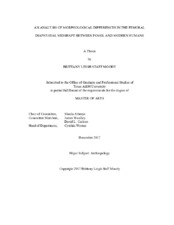An Analysis of Morphological Differences in the Femoral Diaphyseal Midshaft Between Fossil and Modern Humans
Abstract
The understanding of morphological variation between fossil and modern humans
is critical to the discussion of evolutionary processes within the Homo lineage.
Neanderthals are recognizably distinct in their morphology from Late Pleistocene Homo
sapiens and recent modern humans, especially in the femoral midshaft cross-section.
These lineages are often assumed to be independent when applying statistical methods to
account for these morphological differences. The shared evolutionary history of fossil
and modern humans, however, increases the likelihood that the distinction in observable
traits cannot entirely be attributed to divergent selective pressures; morphological
variation is obscured by phylogenetic signal and therefore violates assumptions of
statistical independence. In order to understand the observed variation between these
groups, phylogenetic signal must be taken into account.
To test for phylogenetic signal in the femoral cross-section in recent human
evolution, geometric morphometric shape data was taken from fossil groups
(Neanderthals and Late Pleistocene Homo sapiens) and compared to a global recent
modern human sample. This shape data was isolated from other morphological
constraints through Procrustes superimposition and mapped onto a phylogeny created
from mitochondrial genomes from geographic and temporally comparable populations.
The trends in femoral midshaft cross-sectional shape variation were examined through
Principal Component Analyses and Canonical Variate Analyses and showed
concentrated shape change in the region of the pilaster. A permutation test indicated that
phylogenetic signal is present in the femoral midshaft shape. The presence of this signal
between fossil and modern human groups stresses the importance of taking into account,
and controlling for, shared evolutionary history in comparative analyses. In order to
understand the nature of the phylogenetic signal present in the femoral midshaft,
independent contrasts were calculated and a multivariate regression was performed to
test for the impact of evolutionary allometry.
The results showed that allometric changes throughout modern and fossil human
evolutionary history had an insignificant impact on changes in shape, explaining only
20% of shape variation. This, therefore, suggests that the observed shape changes at the
femoral midshaft between these groups are not due to evolutionary allometry but can be
attributed to other factors, such as behavioral, genetic, or environmental pressures.
Subject
NeanderthalsLate Pleistocene Homo sapiens
femoral cross-section
femora
phylogenetic signal
recent modern human variation
comparative analyses
shared evolutionary history
Citation
Moody, Brittany Leigh Staff (2017). An Analysis of Morphological Differences in the Femoral Diaphyseal Midshaft Between Fossil and Modern Humans. Master's thesis, Texas A & M University. Available electronically from https : / /hdl .handle .net /1969 .1 /173252.


